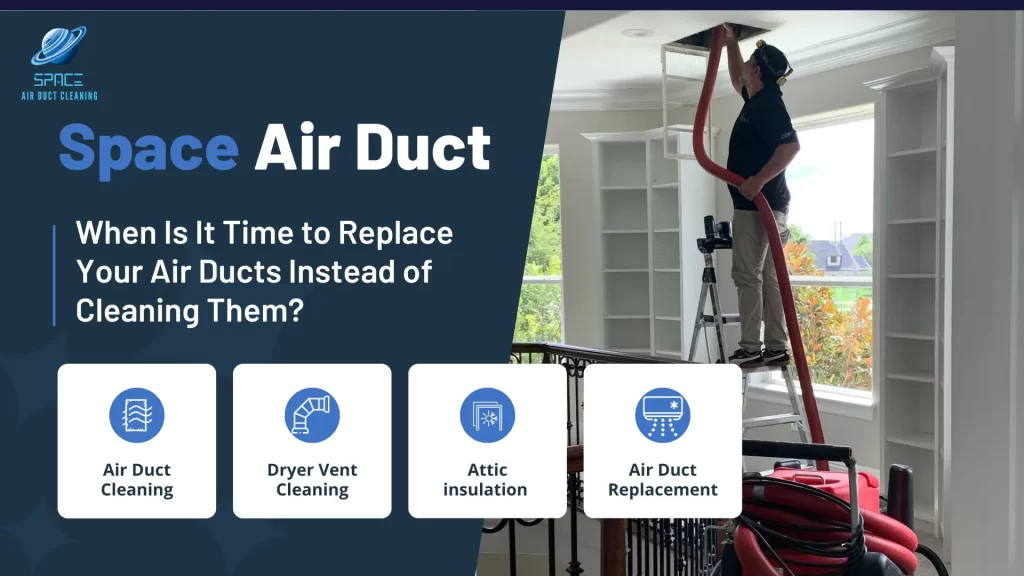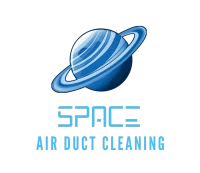The hidden problem that cleaning cannot fix
Cleaning works well for dust and mild debris, freshening airflow and reducing allergens. But it can’t fix leaks, crushed runs, rust, loose seams, or outdated layouts that restrict airflow. When the ductwork itself is failing, replacement is the smarter, longer-lasting choice — like changing worn tires instead of just washing them.
In homes, failing ducts show up as rooms that never heat or cool properly. In businesses, they cause hot and cold spots, drafty work areas, and rising energy bills. If these issues return after cleanings or tune-ups, the real question isn’t “How clean are the ducts?” but “How healthy is the duct system?”
Clear signs that cleaning is not enough
Use this quick checklist. If several apply, replacement should be on the table.
- Severe damage such as crushed or kinked flex runs, torn insulation, rusted metal sections, or disconnected boots at walls and ceilings
- Chronic comfort issues after cleanings, including rooms more than a few degrees off target or very weak airflow from multiple registers
- Visible biological growth inside porous or fiber-lined ducts that cannot be fully removed by cleaning methods
- Major air leaks you can feel at seams and takeoffs, or dirty streaks around joints that return soon after sealing
- Old or wrong-sized duct layout that never supported your equipment or building needs, especially after renovations or tenant build-outs
If you are nodding to more than one of these, duct replacement can solve the root cause rather than treating symptoms.
Age, materials, and layout: why some ducts simply need to go
Ducts don’t last forever. Metal can serve for decades, but rust, water damage, or poor sealing cut that short. Older fiberboard or liner can trap odors and growth that cleaning can’t remove. Flex duct works well, but bends, damage, or long sagging runs restrict airflow even when clean.
Layout is just as important. Additions, remodels, or occupancy changes often leave systems unbalanced, causing noise, pressure issues, and uneven comfort. Updating sections with proper sizing, smoother bends, and shorter runs can boost comfort more than repeated cleanings.
For businesses, the stakes rise — retail needs even temperatures, kitchens and salons need balanced ventilation, and clinics or daycares need reliable airflow to meet health standards. In these cases, replacement safeguards comfort, compliance, and reputation.
How pros decide, testing before touching a single duct
A good contractor does not guess. They measure. The process usually includes a visual inspection, airflow readings at registers, static pressure measurements, and camera or scope checks inside suspect sections. On larger homes and commercial sites, a duct leakage test can quantify how much conditioned air escapes before reaching rooms. The team also reviews equipment data, filter size, and return air capacity, since an undersized return can make a good supply system look bad.
The goal is a clear map of problems with a practical plan. Sometimes replacement is limited to a few critical sections, like a crushed return and leaky plenum. Other times, the best answer is a full supply trunk and branch redesign. Either way, you should see photos, readings, and a simple explanation that ties the findings to your comfort and energy costs.
Replace or repair, making the call and understanding the return
Replacement is an investment, so it helps to frame it in simple terms. If your ducts are leaking a significant portion of conditioned air into the attic or crawlspace, you are paying to heat or cool unused areas. After replacement, more of that air reaches the spaces where people live and work. Thermostats reach set points faster, equipment runs fewer hours, and rooms feel even. Energy bills fall, and the system experiences less wear.
Repairs can still make sense when damage is limited. Sealing metal seams with mastic, replacing a handful of crushed flex runs, adding proper supports, and insulating exposed ducts can buy years of reliable service. But if the system is full of long sags, sharp kinks, rust, or fiber that smells musty after cleaning, replacement removes the weak points in one go. The result is quieter operation, steadier temperatures, and cleaner indoor air.
For property managers, fewer hot and cold calls after hours and a drop in emergency service visits often justify the upgrade by themselves. For owners of restaurants, shops, and salons, better comfort keeps guests on site longer and reduces staff complaints about drafty workstations.
What to expect during a duct replacement
You should know what the process looks like before you approve the work. Here is a simple step-by-step view.
- Assessment and design. The team documents the existing system, calculates required airflow, sizes trunks and branches, and plans routes that avoid tight bends and long sags.
- Protection and access. Floors and work areas are covered, then crews open access to attics, crawlspaces, rooftops, or utility rooms.
- Removal of failed sections. Old duct runs, damaged insulation, and leaky plenums are taken out to the connection points that are still solid.
- Installation of new ducts. Correctly sized metal or flex sections are hung with proper supports, with smooth radius bends and short, direct runs.
- Sealing and insulation. All joints are sealed with mastic or approved tape. Exposed ducts are insulated to the right R value for the location.
- Balancing and testing. Airflow is measured at key registers. Dampers are adjusted so rooms match set targets. Static pressure and temperature splits are verified.
- Clean up and walkthrough. The crew tidies the site and shows you photos and readings so you can see the improvements.
Most projects are planned to limit disruption. Homes can often stay occupied. For businesses, off-hours or phased work keeps operations moving.
Services that pair well with new ducts
Replacement is the perfect time to strengthen the entire HVAC system because access is already open and improvements stack together. Many local homeowners and businesses bundle these services for the best result.
Air duct cleaning can be scheduled before replacement to prevent debris from entering new sections, or shortly after to remove any installation dust. Coil cleaning on the air handler and outdoor unit improves heat transfer so your newly balanced airflow delivers full comfort. A blower wheel cleaning restores designed airflow and lowers noise. If your return is undersized, a return air upgrade reduces static pressure and eases blower strain. Attic insulation top-offs protect new ducts from heat gain. Smart thermostats help manage schedules and track energy use, and indoor air quality upgrades like high-efficiency filters or UV lights keep recirculating air cleaner.
Do not forget safety and maintenance. Dryer vent cleaning reduces fire risk, which matters for homes, laundromats, and multi-unit buildings. Seasonal HVAC tune-ups and filter programs keep everything running smoothly, protect warranties, and extend equipment life. If your building has rooms that are rarely used, simple zoning or damper adjustments can direct more air to where it is needed most.
Ready for a real fix? Let us design a duct system that works
If you keep paying for cleanings but comfort problems and high bills return, it is time to look deeper. Schedule a professional duct evaluation for your home or business. We will inspect accessible runs, test airflow and pressure, and show you exactly where the system falls short. Then we will design a replacement plan that fits your space, your budget, and your schedule.
Ask about bundled savings when pairing duct replacement with air duct cleaning, coil cleaning, blower wheel service, return air upgrades, attic insulation, and a full HVAC tune-up. We offer clear pricing, flexible scheduling, and options for multi-property accounts. Call us today to book your assessment and get a same-week quote. Your rooms will feel better, your staff and guests will notice, and your energy dollars will finally work where they should, inside your building.

